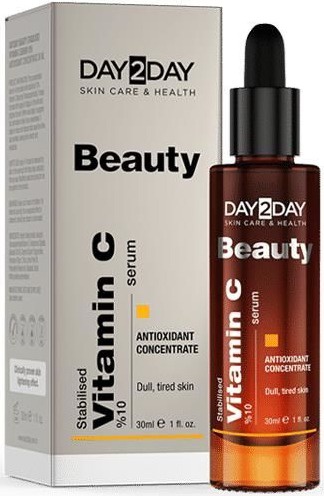
Beauty Stabilised %10 Vitamin C Serum
Highlights
Key Ingredients
Skim through
| Ingredient name | what-it-does | irr., com. | ID-Rating |
|---|---|---|---|
| Heptyl Undecylenate | emollient | ||
| Ascorbyl Tetraisopalmitate (Vitamin C) | antioxidant | ||
| Adansonia Digitata (Baobab Oil) Oil | emollient | ||
| Caprylic/Capric Triglycerides | emollient | ||
| Pentylene Glycol | solvent, moisturizer/humectant | ||
| Citrus Limon Peel Oil | perfuming | icky | |
| Phenylethyl Resorcinol | antioxidant, skin brightening | goodie | |
| Bisabolol | soothing | goodie | |
| Butyl Methoxydibenzoylmethane | sunscreen | goodie |
Day2Day Beauty Stabilised %10 Vitamin C SerumIngredients explained


A super common emollient that makes your skin feel nice and smooth. It comes from coconut oil and glycerin, it’s light-textured, clear, odorless and non-greasy. It’s a nice ingredient that just feels good on the skin, is super well tolerated by every skin type and easy to formulate with. No wonder it’s popular.
A multi-functional, silky feeling helper ingredient that can do quite many things. It's used as an emulsion stabilizer, solvent and a broad spectrum antimicrobial. According to manufacturer info, it's also a moisturizer and helps to make the product feel great on the skin. It works synergistically with preservatives and helps to improve water-resistance of sunscreens.
The essential oil coming from the rind of the lemon that we make (or should make) lemonade from. In general, there are two problems with citrus peel oils: first, they are essentially the fragrant component, limonene in disguise (they are about 85-98% limonene).
Second, they contain the problematic compounds called furanocoumarins that make them mildly phototoxic. Lemon peel contains a medium amount of them, more than sweet orange but less than bergamot. Be careful with it especially if it is in a product for daytime use.
A skin-lightening and antioxidant active ingredient derived from a molecule that exists naturally in Pine tree. According to the clinical results of the manufacturer, 0.5% of phenylethyl resorcinol is more effective than 1% of well-known skin-lightener kojic acid.
Though the results from the manufacturer sound quite promising, a skin-lightening study from 2013 involving phenylethyl resorcinol shows quite moderate results. In the 80 participants, 12-week study, phenylethyl resorcinol was combined with three other actives (disodium glycerophosphate, L-leucine, and undecylenoyl phenylalanine) and only 57% of the participants showed at least a moderate response and 17% did not improve at all.
It's one of the active parts of Chamomile that contains about 30% of bisabolol. It's a clear oily fluid that is used in skincare as a nice anti-inflammatory and soothing ingredient.
The famous Avobenzone. It is a special snowflake as it is the only globally available chemical sunscreen agent that provides proper UVA protection (in the US, new generation sunscreen agents are not approved because of impossible FDA regulations). It is the global gold standard of UVA protection and is the most used UVA sunscreen in the world.
It gives very good protection across the whole UVA range (310-400 nm that is both UVA1 and UVA2) with a peak protection at 360 nm. The problem with it, though, is that it is not photostable and degrades in the sunlight. Wikipedia says that avobenzone loses 36% of its UV-absorption capacity after just one hour of sunlight (yep, this is one of the reasons why sunscreens have to be reapplied after a few hours).
The cosmetic's industry is trying to solve the problem by combining avobenzone with other UV filters that enhance its stability (like octocrylene, Tinosorb S or Ensulizole) or by encapsulating it and while both solutions help, neither is perfect. Interestingly, the combination of avobenzone with mineral sunscreens (that is titanium dioxide and zinc oxide) is not a good idea. In the US, it is flat out prohibited as avobenzone becomes unstable when combined with mineral sunscreens.
As for safety, avobenzone has a pretty good safety profile. It counts as non-irritating, and unlike some other chemical sunscreens, it shows no estrogenic effect. The maximum concentration of avobenzone permitted is 5% in the EU and 3% in the US.
You may also want to take a look at...
| what‑it‑does | emollient |
| what‑it‑does | antioxidant |
| what‑it‑does | emollient |
| what‑it‑does | emollient |
| what‑it‑does | solvent | moisturizer/humectant |
| what‑it‑does | perfuming |
| what‑it‑does | antioxidant | skin brightening |
| what‑it‑does | soothing |
| what‑it‑does | sunscreen |





